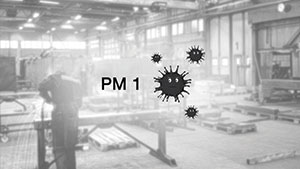Dust particles or particulate matter (PM) are in the air all around us – sometimes we can see them, sometimes we can’t, and the smaller and less perceptible they are, the longer they can stay in the air. The longer they stay in the air, the more likely employees are to breathe them in. And when they are breathed in there can be serious consequences.
 What are PM1 particles – and how do they affect employees?
What are PM1 particles – and how do they affect employees?
The dust that gets into your lungs is called ‘respirable dust’. It includes all particles with a width between 1 and 2.5micrometres. These are known as PM1 and PM2.5. PM1 dust is particulate matter with an aerodynamic diameter of under 2.5 micrometres, and it’s potentially even more damaging than PM2.5, which we know as the typical fine dust and which had previously generated a lot more hype and more research.
PM1 particles come from sources such as combustible fossil fuels (oil, diesel, gas, coal, etc.), power plants and internal combustion engines – among other things – and are the most common pollutants you’ll find in a metropolitan or industrial setting.
PM1 isn’t as widely monitored as PM2.5. But if you’re exposed to significant quantities of dust, you may be affected by it. Consequently, the longer you and your employees breathe it in, the worse the effects. Deep breathing pulls air pollutants faster and further into the lungs.
Zehnder Clean Air Solutions tackles dust at source. The company reports that its clean air systems have been proven to reduce dust particles by up to 90%, ensuring that it’s taken out of the air before employees have a chance to breathe it in.

